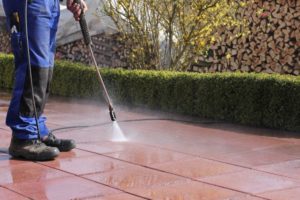The days are getting longer, the birds chirping louder, and everything is beginning to get a bit more colorful! Now that spring is officially here, it’s time to get your home and property ready for open windows and warmer weather! Maybe you’ve already done some spring cleaning inside but spring home and property maintenance is so much more than that. After months of rain, wind, and cold temperatures, some things around your property may have become damaged and now need a little TLC…

General Cleaning Spring is a good time to clean areas of the house that are often left untouched. Dust those hard to reach areas such as window casings, tops of cabinets, and ceiling fans. Vacuum under furniture and along the perimeter of each room. Use a damp cloth to clean wood and vinyl blinds. Consider hiring or renting a carpet cleaner. Anything you can do to remove dust, mites, and other allergens will contribute to a cleaner and healthier home.
Air Conditioning Units Just as you would service your furnace in the fall, now is a good time to make sure your air conditioning units are ready for the warmer months ahead. Filters need to be changed, hose connections checked, and drain pans need inspections.
Inspect Gutters and Downspouts Gutters and downspouts must be free of debris and damage to correctly direct water away from your home’s foundation. Even if you live in an area of the country that doesn’t see much rainfall, check both to prevent an overflow if a storm hits. Gutter and downspout clogs can cause damage to your basement, roof, or fascia, and can result in costly repairs.
Inspect Caulking Around Doors and Windows Experts recommend replacing the caulk around windows and doors each spring, as cold temperatures can cause cracks, which lets air leak in and out of your home. Water also can get in where it shouldn’t through cracked caulk.
Remove Mildew and Moss From Decks and Patios With Pressure Washer Pressure washing sprays away unwanted mildew or moss from just about any surface. Use it to clean your tile patio, wooden deck, or concrete driveway and/or walkway. If you do pressure wash a wooden surface, give it a fresh coat of stain or sealant to keep it protected and looking its best.

Siding Clean siding with a pressure washer to keep mold from growing. Check all wood surfaces for weathering and paint failure. If wood is showing through, sand the immediate area and apply a primer coat before painting. If paint is peeling, scrape loose paint and sand smooth before painting.
Clean and Inspect Window Screens Give your window screens a once-over to ensure no critters or pests can work their way through bent frames, holes or tears. A little work now will keep you from having to remove unwanted guests from your home.
Remove Trees and Shrubs from Around House Trees and shrubs that are too close to your home can brush up against gutters and cause damage during a windstorm. Foliage also can damage siding and creates access for an insect infestation. Trim foliage that brushes up your home to help prevent all of this.
Inspect Laundry Room Hoses for Cracking Your laundry room also can be a source of flooding. Check the water-supply hoses each spring for cracks. When replacing these hoses, install a new washer at the end instead of reusing an old one that might have clogs or wear.
Lawns Rake the lawn to remove any branches, debris and leaves that you might have missed in the fall; if left, they can suffocate the grass beneath. During the winter, soil compaction, along with chemical changes altering your soil’s PH, may have left your lawn vulnerable to weed growth and other issues. Even if you can’t see weeds, they are more than likely waiting for optimum conditions to propagate.
Inspect Outdoor Water Systems Make sure pipes, faucets, and in-ground sprinkler systems are in working order. Check lawn sprinkler systems for leaky valves, exposed lines, and improperly working sprinkler heads. If there is an area of your yard that collects too much water or doesn’t get enough, run the sprinklers to figure out the problem. If it’s not something you can fix yourself, call a professional before your lawn needs the water. Once the ground thaws completely, you’ll want to have all of these systems ready to maintain the new plants you just installed for the spring and summer.
Foundation Check foundation walls, floors, concrete, and masonry for cracking, heaving, or deterioration. If a significant number of bricks are losing their mortar, call a foundation professional. If you can slide a nickle into a crack in your concrete floor, slab or foundation call a professional immediately.
Roof Inspect roof surface flashing, eaves, and soffits. Perform a thorough cleaning and replace any shingles that might have gotten damaged or fallen off during the fall and winter.
Deck and Porches Check all decks, patios, porches, stairs, and railings for loose parts and/or deterioration. Open decks and wood fences need to be treated every 4-6 years, depending on how much exposure they get to sun and rain. If the stain doesn’t look like it should or water has turned some of the wood a dark grey, it’s probably time to treat your deck and fence.
Look for Moisture in Basement and Crawl Space When you do get a good rain, look for leaks in your crawl space or basement that could turn into costly repairs. Also check regularly under bathrooms, the kitchen, and laundry room to ensure pipes are intact.
Outdoor Furniture If you stored your lawn furniture for the winter, bring it outdoors and give it a hose rinse, or wash it with a mild detergent. For metal furniture, check for signs of rust or paint erosion; a simple remedy of spray enamel will prevent further damage from sun, rain and humidity in the months ahead.
